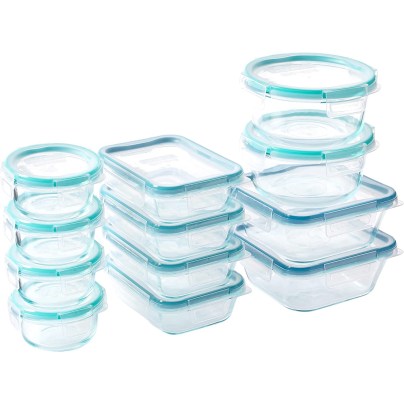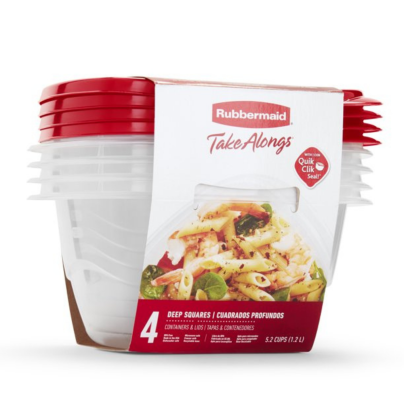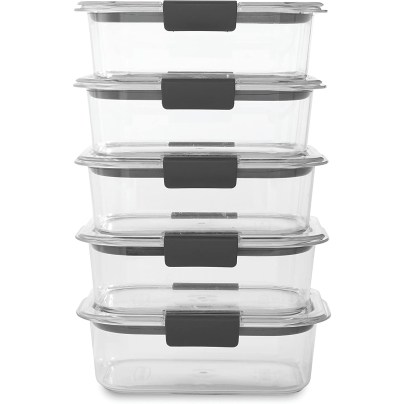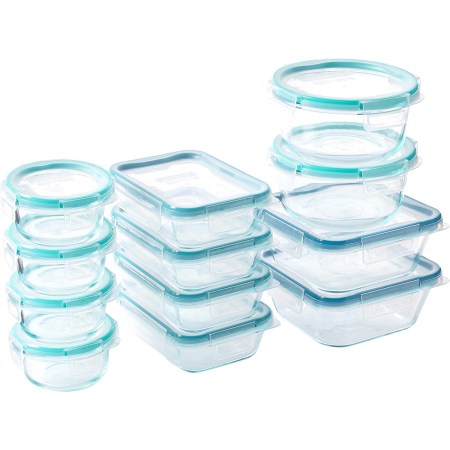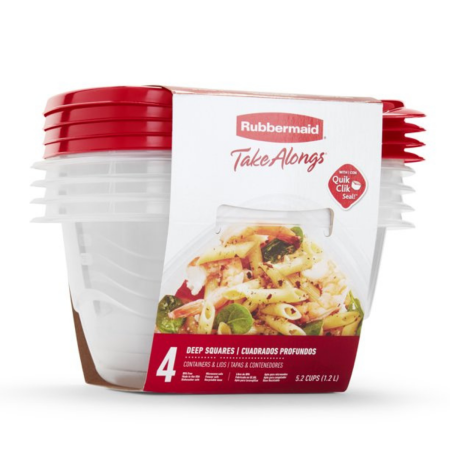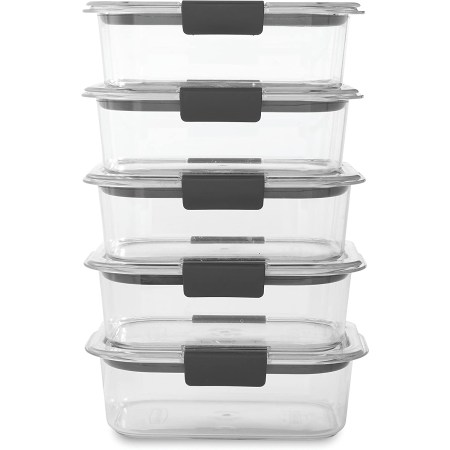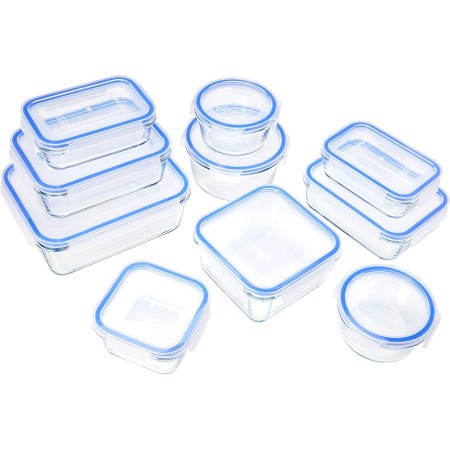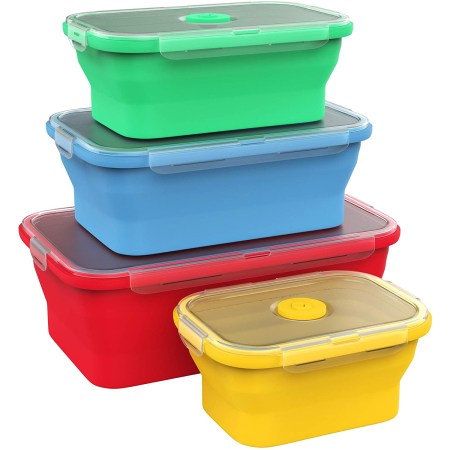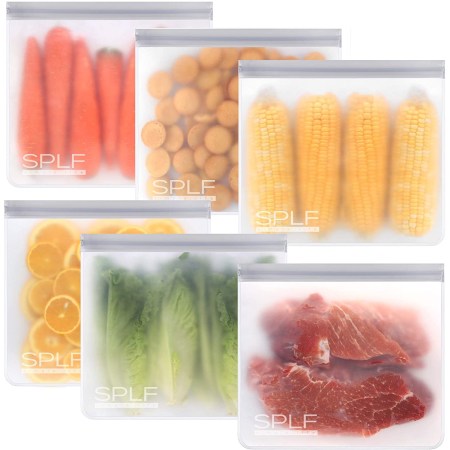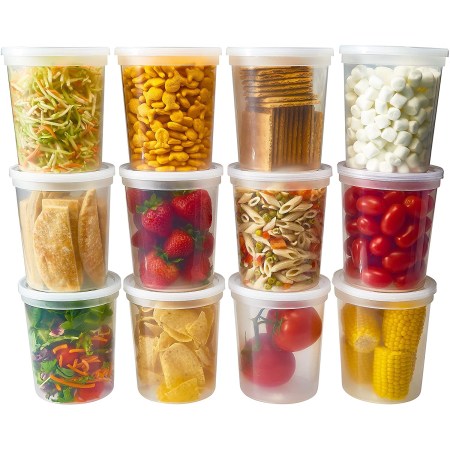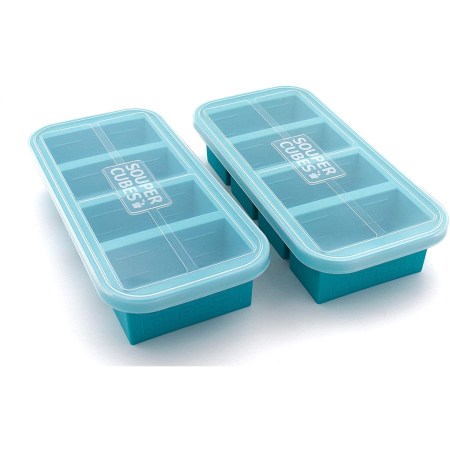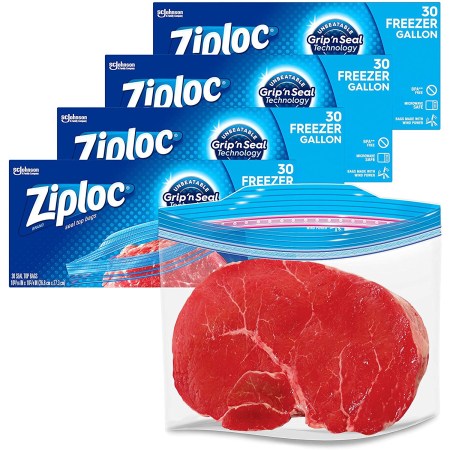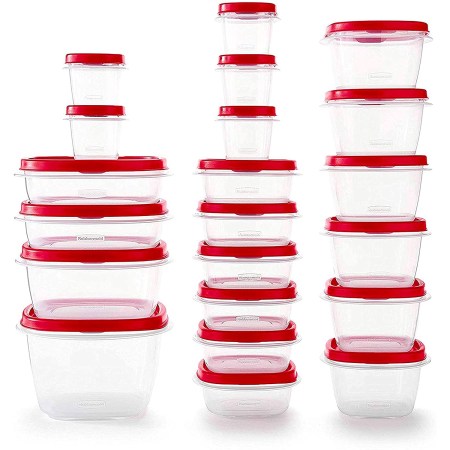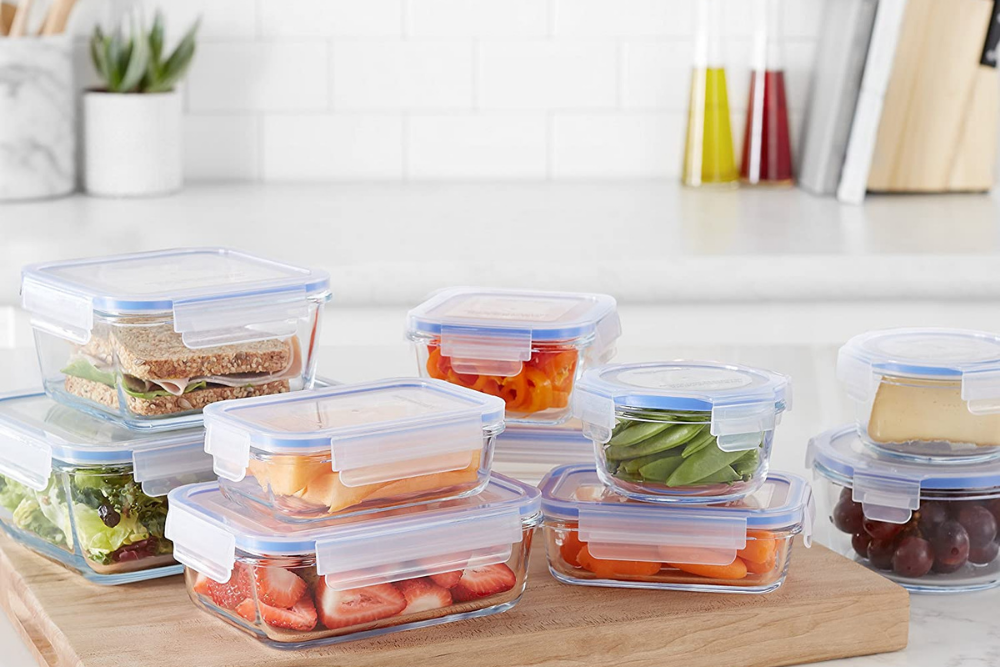
We may earn revenue from the products available on this page and participate in affiliate programs. Learn More ›
Freezer-safe storage containers offer an excellent way to keep food fresh and avoid waste. They’re a great choice for leftovers, but they also come in handy if you like to prepare a week’s worth of meals in advance or make extra-large batches of soup or sauce. Not all freezer containers are alike, however, differing in size, material, and quality. Use this guide to find the best freezer containers that will meet your needs in terms of convenience, style, and economy.
- BEST OVERALL: Snapware Total Solution Glass Food Storage Set
- BEST BANG FOR THE BUCK: Rubbermaid TakeAlongs Deep Storage Containers
- BEST PLASTIC: Rubbermaid Brilliance Food Storage Containers
- BEST GLASS: Amazon Basics Glass Locking Lids Food Storage
- BEST COLLAPSIBLE: Vremi Silicone Food Storage Containers
- BEST BAGS: SPLF 6 Pack BPA FREE Reusable Gallon Freezer Bags
- BEST LARGE: DuraHome Deli Food Storage Containers with Lids
- BEST FOR LIQUIDS: Souper Cubes Large Silicone Tray
- BEST DISPOSABLE: Ziploc Gallon Food Storage Freezer Bags
- BEST MULTIPACK: Rubbermaid Vented Lids Food Storage
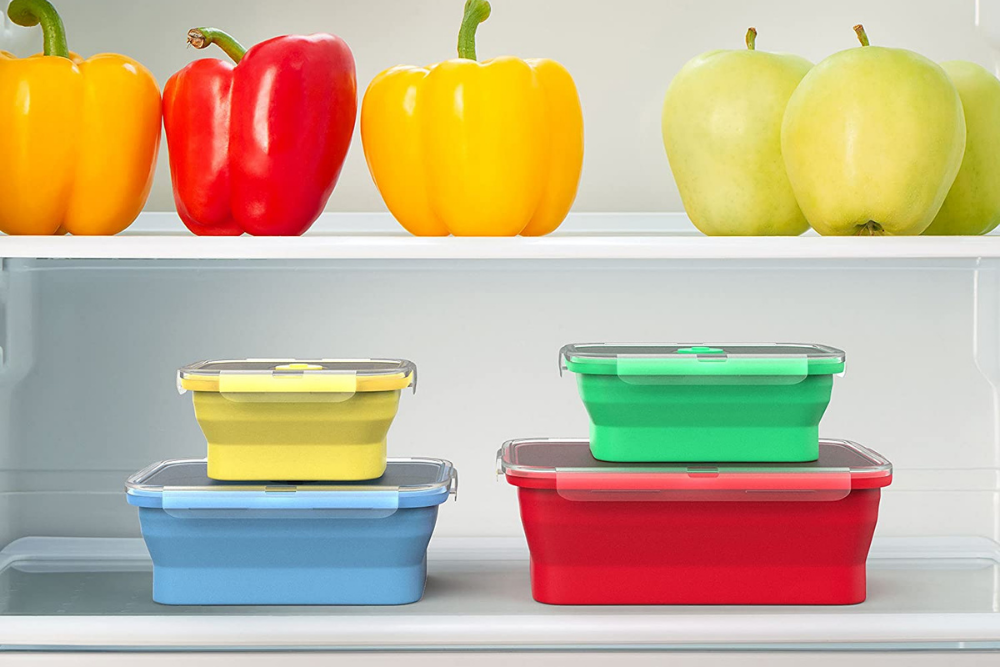
What to Consider When Choosing Freezer Containers
When choosing freezing containers, it’s important to keep in mind how you intend to reheat the food: in the microwave or in the oven. You’ll also want to consider if the container will be large enough for the contents you aim to store, and if you plan to take food to go in them. Read on for must-know info that will help you shop smarter.
Material
Material is a crucial factor since it relates directly to your preferred reheating method and appliance. Today’s freezer storage containers are typically made of glass, plastic, or silicone—each with pluses and minuses.
Glass is an all-around good choice because it’s both oven and microwave safe. It’s also transparent so you can see what’s inside, and it’s dishwasher safe for easy cleaning. But glass is heavy, so perhaps it’s not ideal if you want to pack it in a lunchbox. It’s also a fragile material that could chip or shatter if dropped.
Plastic containers are durable and lightweight, yet while usually microwave safe, they cannot be heated in the oven. They can also typically be cleaned in the dishwasher, though some must be placed on the top rack only because the bottom rack may get too hot and damage the plastic.
The best plastic freezer containers eschew bisphenol A (BPA), an industrial chemical that can seep into food or beverages, potentially causing health problems for developing fetuses and children; research also points to a possible link between BPA and cardiovascular disease, increased blood pressure, and Type 2 diabetes.
Silicone is a durable yet flexible material with a nonstick texture that allows frozen foods to release with ease. It’s generally oven safe (check product information for the highest temperature a particular container can tolerate) as well as microwave and dishwasher safe. Silicone containers may be collapsible for compact storage and, because it lasts longer than plastic, it’s a more eco-friendly option.
Size and Shape
Freezer containers come in a variety of sizes and shapes to suit different storage space capacities and configurations, as well as user preferences. Size-wise, they range from about 4 ounces to a gallon, with 4 cups considered average and 10 cups deemed large. Shapes may be round (like bowls), square, or rectangular. Freezer bags are typically sold in pint, quart, and gallon sizes.
If you plan to reheat individual meals in the container, it should be the right size for your ideal serving. The container should also be easy to eat from. A round, bowl-style container, for instance, suits soup and pasta, while a square-cornered model is better for sturdier foodstuffs like chicken and veggies. Square and rectangular-shaped containers are also easier to store in a crowded freezer.
Freezer bags are often used for storing liquids like soups and sauces because they’re often available in larger sizes. Upon sealing, the bags can lay flat in the freezer, conserving space. Freezer bags are typically transparent so the contents can be seen at a glance, and often there’s an opaque section on the bag where you can write the date and a description for reference.
Weight and Portability
Plastic is lightweight, so it’s a smart choice for taking food storage containers on the go. It’s also the least expensive material, so no great hardship if it’s inadvertently left behind. Silicone is somewhat pricier, but it’s also a durable, lightweight option for commuters. A glass container could prove too heavy to tote to and from work every day if you’re walking or taking public transportation.
Leakproof Lid
A leakproof lid is key to successful freezer storage, especially for liquids. Leakproof lids prevent spills during transport and in the freezer before the substance solidifies—important, since frozen spills can be very challenging to clean.
Ideally, a leakproof lid will also create an airtight seal to prevent the formation of ice crystals that form as a result of moisture loss—commonly called “freezer burn.” Food with freezer burn is safe to eat, but it may not taste as good, so that airtight seal will help food stay fresh-tasting for a longer period of time.
Some microwave-safe lids also have a venting system that lets steam escape while the food heats. This prevents explosive splatters that could make a mess in the microwave.
Microwave, Dishwasher, and Oven Safety
A chief convenience of freezer storage containers is the ability to reheat food right inside them. Glass versions are the most versatile choice as they’re the only type of food storage container that’s safe to put in the oven, microwave, and dishwasher. Most plastic and silicone freezer containers are microwave and dishwasher safe, which also adds to their durability. Freezer storage bags are generally microwavable (check the packing to confirm) but should not be reused or cleaned in the dishwasher.
Tips for Using the Best Freezer Containers
Get the best use out of your freezer containers with these tips:
- Let food cool before putting it in the freezer to prevent contamination.
- Stack containers to maximize space.
- Don’t overfill containers, especially when storing liquids, because food may expand and contract when freezing and defrosting. Fill no higher than ⅛ inch from the top of the container to avoid spills.
- Check that the lid is properly closed. If the lid has latches, ensure that they’re secured in place.
- Allow food to defrost in the fridge before heating in the microwave or oven to help it cook evenly and prevent food poisoning.
- When using freezer bags, carefully squeeze out all the excess air before sealing. Never press down in an attempt to remove air from a sealed bag because it will likely pop and the bag will break.
- Containers with a vented lid are ideal for even heating in the microwave while preventing splatters. If the lid isn’t vented, keep it on top of the contents but not sealed, or remove it and heat with a paper towel or piece of wax paper atop the food.
Our Top Picks
The freezer containers described here were chosen according to the criteria detailed above as well as consumer satisfaction, ease of use, and price.
Best Overall
Snapware Total Solution Glass Food Storage Set
The Snapware Total Solution Glass Food Storage Set features different sizes of square, rectangular, and round freezer containers—12 in all. These containers are made from Pyrex glass, a quality brand known for durability and heat resistance.
Latched lids open and close with ease to form a leakproof and airtight seal. The containers and the lids are both dishwasher safe, but the lids must be placed on the top rack only. Both the bases and the lids are stackable for compact storage.
Product Specs
- Material: Glass and plastic
- Total containers: 12
- Dimensions: Various
Pros
- Durable Pyrex glass
- Microwave, oven, and dishwasher safe
- Leakproof, airtight lids
Cons
- Lids are only top-rack dishwasher safe
- Heavy
Best Bang For The Buck
Rubbermaid TakeAlongs Deep Storage Containers
Quality freezer-safe food storage needn’t take a bite out of your budget, thanks to Rubbermaid TakeAlongs. The set of four food storage containers is made of lightweight, microwave-safe plastic, so they’re a smart choice for commuters who like to bring leftovers to work for lunch.
TakeAlongs feature gradation markings on the side for easy measuring. This is helpful when freezing recipe ingredients like broth, which makes the containers useful for meal prep. The containers and lids are dishwasher safe and stackable.
Product Specs
- Material: Plastic
- Total containers: Four
- Dimensions: 6.37 by 6.98 by 5.07 inches
Pros
- Microwave and dishwasher safe
- Lightweight
- Stackable for compact storage
Cons
- Not oven safe
Best Plastic
Rubbermaid Brilliance Food Storage Containers
Thick, rigid, and crystal clear, these BPA-free plastic containers from Rubbermaid boast the look of glass without the weight. They make it easy to identify what’s stored inside, no labeling required, and can be toted to work or a potluck with ease.
The latched lids are airtight and have built-in vents under the latches for splatter-free microwave heating. They come in a variety of sizes and are sold in packs of two, four, and five.
Product Specs
- Material: Plastic
- Total containers: Two, four, or five
- Dimensions: 10.2 by 8.19 by 5.67 inches
Pros
- Leakproof and airtight
- Stackable for storage
- Lid vents for microwave usage
Cons
- Latches could be more durable
Best Glass
Amazon Basics Glass Locking Lids Food Storage
For the versatility and convenience of glass in a host of sizes, consider this set of 10 storage containers from Amazon Basics. There’s a variety of sizes and shapes, including bowls, rectangular shapes, and square shapes to suit different foodstuffs.
Locking lids boast a nifty silicone ring to help prevent spills. The containers are oven safe up to 752 degrees Fahrenheit, and while dishwasher safe, the lids should be placed on the top rack only.
Product Specs
- Material: Glass and plastic
- Total containers: 10
- Dimensions: Various
Pros
- Variety of shapes and sizes
- Dishwasher, microwave, and oven safe
- Stain resistant
Cons
- Lids safe for dishwasher top rack only
- Comparatively expensive
Best Collapsible
Vremi Silicone Food Storage Containers
Vremi Silicone Food Storage Containers are so flexible, they can be flattened out when not filled with food for the ultimate in compact storage.They take up a fraction of the real estate of glass and plastic food storage containers, making them a blessing for small kitchens short on cabinets and freezer space.
Plus, the texture of silicone is nonstick, so frozen foods pop out easily—no more smacking iced-up blocks of food on the countertop to release leftovers. The material is microwavable with airtight lids that vent automatically in the microwave, and both lids and containers are dishwasher safe—but unlike some silicone containers, these are not oven safe.
Product Specs
- Material: Silicone
- Total containers: Four
- Dimensions: Various
Pros
- Collapses for compact storage
- Durable
- Nonstick texture for slide-out food removal
Cons
- Small size
- Not oven safe
Best Bags
SPLF 6 Pack BPA FREE Reusable Gallon Freezer Bags
Though a decent option for storing liquids like purees, sauces, and soups, freezer bags are typically disposable. That’s what makes these reusable bags for the freezer such a welcome addition to the market. While they are not dishwasher safe (clean with soap, water, and possibly a sponge), the bags can be reused hundreds of times, so they’re a far more planet-friendly option than throwaway versions.
The 1-gallon size is ample, and the bags are sold in a pack of six. They boast an easy-to-use, leakproof zipper seal. Note that food cannot be reheated in them, as they are neither oven nor microwave safe, but they’re durable enough to take on the go.
Product Specs
- Material: Polyethylene Vinyl Acetate
- Total containers: Six
- Dimensions: 1 gallon
Pros
- Reusable
- Great for liquids
- Ample 1-gallon size
Cons
- Not oven, microwave, or dishwasher safe
Best Large
DuraHome Deli Food Storage Containers with Lids
Folks in a catering or other food-service business, or those who simply prefer to prep and cook in large quantities, should consider these DuraHome containers. Sold in an affordable pack of 24, the tall, cylindrical containers hold a quart (32 ounces)—a size and shape familiar from restaurant takeout. The reusable containers are microwave safe and can be cleaned on the top rack of the dishwasher. While the manufacturer claims the lids to be leakproof, exercise caution during transport.
Product Specs
- Material: Plastic
- Total containers: 24
- Dimensions: 9.2 by 4.5 by 16 inches
Pros
- Great for food service businesses
- Microwave safe
- Popular size and shape
Cons
- Not durable
- Only top-rack dishwasher safe
Best For Liquids
Souper Cubes Large Silicone Tray
While it’s possible to freeze liquids for recipes and small batches of pesto, applesauce, or baby food in standard silicone ice cube trays, those foods are bound for freezer burn. Souper Cubes solves the problem, because these inventive silicone trays include lids to keep foods fresh.
Each tray makes eight separate 1-cup portions. Simply fill, cover, and freeze; when it’s time to defrost, the cubes pop out with ease. These versatile trays are oven safe up to 415 degrees Fahrenheit, so they can also be used to bake such small treats as brownies.
Product Specs
- Material: Alloy steel frame and silicone
- Total containers: Two
- Dimensions: 11.5 by 4.7 by 5.5 inches
Pros
- Ideal for freezing small portions
- Has marked fill lines
- Includes two stackable trays
Cons
- Only oven safe to 415 degrees Fahrenheit
Best Disposable
Ziploc Gallon Food Storage Freezer Bags
Reusable freezer containers are certainly the eco-conscious choice, but when a disposable option is a must, consider Ziploc Gallon Food Storage Freezer bags. They’ve been a convenient, reliable kitchen staple for years, thanks to a triple system seal that features an extended tab, an easy grip texture, and a double zipper.
These bags are designed to prevent freezer burn, and they’re easy to label with the date right on the bag, making freezer inventory more convenient. The gallon size is generous, and there are 120 bags per box. The disposable bags are not safe for the oven or dishwasher.
Product Specs
- Material: Plastic
- Total containers: 120
- Dimensions: 1 gallon
Pros
- Easy to use
- Convenient
- Generously sized
Cons
- Not a sustainable choice
Best Multipack
Rubbermaid Vented Lids Food Storage
This set of freezer storage containers strives to check all the boxes. It includes 21 containers of different sizes and shapes (and if that’s not enough, a 60-piece set is also available). The smallest container is just half a cup, while the largest holds 7 cups. The pieces are lightweight for portability.
Many of the BPA-free plastic containers have vented lids to prevent splattering in the microwave. The lids also stack together for efficient storage in the pantry. Lids and containers are dishwasher safe.
Product Specs
- Material: Plastic
- Total containers: 21
- Dimensions: Various
Pros
- Large variety of sizes
- Portable
- Lids snap together for compact storage
Cons
- Not oven safe
Our Verdict
Glass food storage containers like the Snapware Total Solution Glass Food Storage Set will meet most storage and cooking needs while deterring freezer burn. If portability and affordability are prime considerations, go for the lightweight plastic of Rubbermaid TakeAlongs.
How We Chose the Best Freezer Containers
All the criteria discussed in detail above went into the selection of the freezer containers described in this guide. Safety, versatility, and convenience are all key considerations when it comes to freezer containers. We ensured that our recommendations had airtight lids to deter freezer burn and keep food fresh. We looked for products that are easy to use, clean, and store.
Brand recognition was also a factor, so offerings from reliable manufacturers like Snapware, Rubbermaid, and Ziploc were valued. Customer reviews, both the number of reviews as well as high ratings, held significant weight as well.
The Advantages of Owning the Best Freezer Containers
Freezer containers help avoid food waste, saving consumers money. They allow you to safely freeze both leftovers and full meals prepared in advance. Some are lightweight and portable, ideal for taking lunch to work, while others are large enough to hold dinner for the family—which can be a real blessing during busy times when cooking isn’t an option. Freezer storage containers allow a convenient way to have fresh-tasting food on hand, and they come in such a wide variety of sizes, shapes, and materials that there should be ample options for any household.
- Reduce food waste
- Save money
- Save time
FAQs
Freezer containers can be a great convenience in the kitchen. If you still want more information on the best way to choose and use them, read on for the answers to some of the most common questions about these products.
Q. How do I freeze food properly in a freezer container?
Use the right-sized container for the amount of food you wish to freeze, and avoid overfilling to prevent spills when food contracts and expands as it freezes and defrosts. Ensure that the lid is closed securely and sealed properly before placing the container in the freezer.
Q. Is it better to freeze food in plastic or glass?
When it comes to food safety, it’s best to freeze in freezer-safe glass because there’s no need to worry about BPA from plastic potentially leaching into your food.
Q: What plastic is freezer safe?
Some types of plastic including polypropylene and PVC are freezer safe, but be sure to check labels because freezer safeness should be noted. It’s best to use plastic containers that are labeled BPA-free.
Q: Are all Ziploc bags freezer safe?
Technically, no. It’s best to use Ziploc freezer bags for the freezer. Regular Ziplocs won’t prevent freezer burn.
Q: Are all mason jars freezer safe?
No, only mason jars with straight sides are freezer safe.
